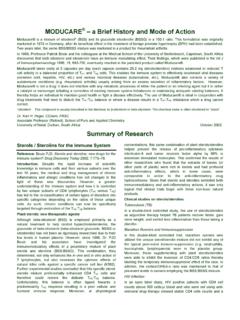Transcription of Natural Gas: A Summary of the History, Uses, and ...
1 This research was prepared with support from the National Energy Technology Labs, URS, and Wilkes University s Institute for Energy & Environmental Research. This primer contains a brief history of domestic Natural gas uses and consumption. The influence of shale gas drilling is discussed with particular emphasis on Marcellus Shale. The paper is accompanied by case studies from business and government entities who have made successful transition to CNG from another fuel source. Natural Gas: A Summary of the History, Uses, and Consumption with a Discussion on the Influence of Domestic Shale Drilling. This Primer is Accompanied by Case Studies December 2011 Updated April 2012 Page | 1 December 2011 Natural Gas: History, Uses, and Consumption Natural gas is a mixture of several hydrocarbon gases, containing seventy to ninety percent methane in most cases.
2 Other common molecules include ethane, propane, butane, carbon dioxide, oxygen, nitrogen and hydrogen sulfide. Over millions of years, decayed plant and animal matter builds up in layers in the earth and becomes trapped by sand and silt that turns to rock. The organic matter, through a process of heat and pressure under this rock, then turns to coal, oil, or Natural gas. Natural gas is considered dry when it is almost purely methane, and wet when there is a significant amount of other hydrocarbons. The process for gas drilling begins with geologists locating the type of rock that will likely contain gas. Geologists then use seismic surveys (involving echoes and vibrations) to gain information about the rock. If the area seems like it will yield Natural gas, drilling begins.
3 Drilling can be performed on land (onshore) or in the ocean (offshore). Compared to onshore drilling, where there is ground on which to stabilize drilling machines, offshore drilling is much more complicated. Historically for onshore drilling, the percussion method was used. This involved lowering a heavy metal drill bit into the earth over and over to create a hole. This method was largely abandoned, because it could not reach depths of more than 400 or 500 feet, on average. For offshore drilling, the wells are deep beneath the surface of the ocean, and artificial platforms are constructed on the surface. The first offshore rig was built and used in 1869, but it was not until 1974 that drilling was done far out in the ocean in deep water namely, in the Gulf of Mexico. The original rigs, like the one patented by T.
4 F. Rowland in 1869, were designed to work solely in very shallow water. The rigs that are used today have a similar four-legged design to the earliest models, but are able to drill in very deep water. Deep sea rigs have specific components that allow them to function efficiently. The two most important features are the subsea drilling template and blowout preventer. The subsea drilling template connects the drilling site to the platform at the surface of the water, and the blowout preventer is in place to prevent oil or gas from leaking into the water. Today, there are two main types of deep sea rigs movable and unmovable. Moveable rigs are able to move from location to location and drill in multiple places, while unmovable rigs remain in one place only.
5 Moveable rigs are less expensive and are used many times for exploratory purposes. There are also various other types of rigs, including drill ships and drilling barges. Once Natural gas is extracted from onshore and offshore sites, it is transported to consumers by way of pipelines. Before it reaches the pipelines, however, it needs to be purified into the state it will be in when it enters homes and businesses. This requires the separation of various hydrocarbons and fluids from the pure Natural gas to produce pipeline quality dry gas. Restrictions are placed on the quality of Natural gas that is allowed to enter pipelines. Natural gas is also sometimes stored in large underground areas because demand is higher in different seasons of the year.
6 From the Page | 2 December 2011 large pipelines, the gas goes into smaller pipelines called mains, and then further into even smaller pipes called services that lead directly into homes and buildings to be heated. Natural gas can also be cooled to a very cold temperature and stored as a liquid. Turning the gas into a liquid allows for easier storage because it takes up less space. Then, when it needs to be distributed, it is returned to its original state and sent through pipelines. Natural gas is among America s most heavily used sources of energy. In the mid to late 1800 s, wood was the country s main energy source. As we moved into the 1900 s, coal became increasingly popular and remained so throughout the 20th century. Also during this century, nuclear electric power became a new, popular energy source.
7 The three major fossil fuels petroleum, coal, and Natural gas have totaled to 87% of energy use is the past decade, and have been the nation s top fuels for well over one hundred years. Natural gas consumption and production was mostly equal in 1986. Since then, we have seen an increase in the consumption of and the need for imported gas. Between 2006 and 2010, domestic Natural gas production increased with the use of more efficient, cost effective drilling techniques. Source: US Energy Information Administration In 2010, Natural gas accounted for approximately 25% of energy consumption. In 2009, the top states for Natural gas consumption were Texas, California, Louisiana, New York, Florida, and Illinois. Natural gas is consumed in a number of ways.
8 Most Natural gas consumption occurs in the home, as a heat source for homes and water. More than half of all homes in the use Natural gas as their main home heating source. Natural gas is also used by manufacturing industries it is considered a raw material as it serves as a hear source for various manufacturing processes. It is used to produce steel, glass, paper, clothing, brick, and electricity. Industry is the largest consumer of Natural gas, accounting Page | 3 December 2011 for 43% of all Natural gas consumption. The most common industrial uses of Natural gas are in the pulp and paper, metals, chemicals, petroleum refining, stone, clay and glass, plastic, and food processing industries In the 1800 s, Natural gas was mainly extracted from coal to be used locally. However, in the early 1900 s Natural gas began to be moved across state lines.
9 This left states unable to accurately monitor Natural gas sales. For almost 40 years, the federal government also failed in its attempts to regulate the industry. Finally, the Natural Gas Act of 1938 gave the Federal Power Commission (FPC) the ability to regulate Natural gas prices from the pipeline to the consumer. In 1942, the FPC was also granted authority to oversee the construction of interstate pipelines. In 1954, the Supreme Court ruled in Phillips Petroleum v. Wisconsin that the FPC had authority over the gas producers who were selling to interstate pipelines. This meant that the FPC had the power to regulate prices from the wellhead to the pipeline. The FPC struggled in the years after the Phillips Petroleum v. Wisconsin decision to take on the administrative responsibility of regulating Natural gas producers.
10 The FPC s decision to handle each Natural gas producer individually was often considered to be the reason for Natural gas shortages in the 1970 s. The Natural Gas Policy Act of 1978 began to deregulate the Natural gas industry and allow the supply and demand to equalize. In the early 1980s, price changes lowered demand significantly and surpluses were faced, but the issue eventually resolved. Barriers between interstate and intrastate Natural gas markets were broken down and the price regulation was substituted with a price ceiling by 1985. The Natural Gas Wellhead Decontrol Act of 1989 enacted a plan that phased out all regulation by 1993. Such deregulation allows gas producers to sell directly to marketers, local distribution companies, and/or the end user. In 2002, the produced about of the world s Natural gas.









